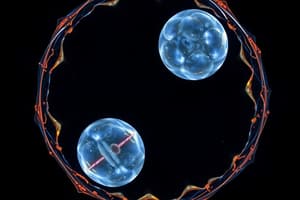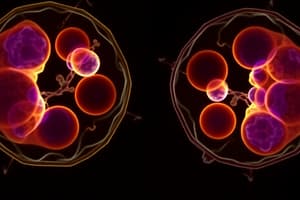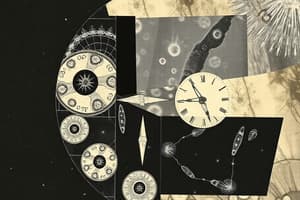Podcast
Questions and Answers
What is a daughter cell?
What is a daughter cell?
A new cell formed by cell replication.
What is a zygote?
What is a zygote?
A diploid cell resulting from the fusion of an egg and sperm.
What is an embryo?
What is an embryo?
An early stage in the development of human, animal, or plant species.
What is mitosis?
What is mitosis?
What is cytokinesis?
What is cytokinesis?
In prokaryotes, the point at which the chromosome is attached to the plasma membrane is called the _____.
In prokaryotes, the point at which the chromosome is attached to the plasma membrane is called the _____.
What is binary fission?
What is binary fission?
What constitutes the cell cycle?
What constitutes the cell cycle?
Interphase is the phase in the cell cycle when the cell is actively undergoing mitosis.
Interphase is the phase in the cell cycle when the cell is actively undergoing mitosis.
What occurs during the G1 phase of the cell cycle?
What occurs during the G1 phase of the cell cycle?
What is the G0 phase?
What is the G0 phase?
The _____ phase of interphase is when chromosomes are replicated in the nucleus.
The _____ phase of interphase is when chromosomes are replicated in the nucleus.
What is a chromatid?
What is a chromatid?
What is the function of the centromere?
What is the function of the centromere?
The G2 phase is the first phase of interphase.
The G2 phase is the first phase of interphase.
What characterizes prophase?
What characterizes prophase?
What are centrioles?
What are centrioles?
What is the mitotic spindle?
What is the mitotic spindle?
During _____, the stage of mitosis between prophase and anaphase, chromosomes line up along the middle of the cell.
During _____, the stage of mitosis between prophase and anaphase, chromosomes line up along the middle of the cell.
What key event occurs during anaphase?
What key event occurs during anaphase?
Telophase is the stage of mitosis that occurs immediately after prophase.
Telophase is the stage of mitosis that occurs immediately after prophase.
What is DNA replication?
What is DNA replication?
What are mutations?
What are mutations?
What is the significance of the G1 checkpoint?
What is the significance of the G1 checkpoint?
_____ are protein molecules that act as biological catalysts to speed up biochemical reactions.
_____ are protein molecules that act as biological catalysts to speed up biochemical reactions.
What are apoptotic bodies?
What are apoptotic bodies?
What is the role of phagocytic cells in the context of apoptosis?
What is the role of phagocytic cells in the context of apoptosis?
What is the mitochondrial pathway of apoptosis?
What is the mitochondrial pathway of apoptosis?
What are caspases?
What are caspases?
The death receptor pathway is the only pathway by which apoptosis can be initiated.
The death receptor pathway is the only pathway by which apoptosis can be initiated.
What are blebs in the context of apoptosis?
What are blebs in the context of apoptosis?
What is tissue culture?
What is tissue culture?
A region of repetitive DNA sequences found at the end of a chromosome is called a _____.
A region of repetitive DNA sequences found at the end of a chromosome is called a _____.
What is a neoplasm?
What is a neoplasm?
Define cancer.
Define cancer.
What are oncogenes?
What are oncogenes?
Proto-oncogenes are mutated genes that cause cancer.
Proto-oncogenes are mutated genes that cause cancer.
What is the function of tumour-suppressor genes?
What is the function of tumour-suppressor genes?
What are embryonic stem cells?
What are embryonic stem cells?
What are adult stem cells?
What are adult stem cells?
What does 'potency' refer to in the context of stem cells?
What does 'potency' refer to in the context of stem cells?
A _____ cell is an isolated cell, like a zygote, that is capable of developing into a complete, fertile adult individual and all extraembryonic tissues.
A _____ cell is an isolated cell, like a zygote, that is capable of developing into a complete, fertile adult individual and all extraembryonic tissues.
What does it mean for a cell to be pluripotent?
What does it mean for a cell to be pluripotent?
What are germ layers?
What are germ layers?
What does it mean for a stem cell to be multipotent?
What does it mean for a stem cell to be multipotent?
Unipotent stem cells are capable of developing into many different types of cells or tissues.
Unipotent stem cells are capable of developing into many different types of cells or tissues.
List the key steps involved in the process of apoptosis described.
List the key steps involved in the process of apoptosis described.
Define embryo.
Define embryo.
Define cytokinesis.
Define cytokinesis.
In prokaryotes, what is the 'origin'?
In prokaryotes, what is the 'origin'?
Define the cell cycle.
Define the cell cycle.
What is interphase?
What is interphase?
What occurs during the S phase?
What occurs during the S phase?
Define chromatid.
Define chromatid.
What is a centromere?
What is a centromere?
Define the mitotic spindle.
Define the mitotic spindle.
What happens during metaphase?
What happens during metaphase?
What occurs during anaphase?
What occurs during anaphase?
Describe telophase.
Describe telophase.
Define mutations.
Define mutations.
What is the G1 checkpoint?
What is the G1 checkpoint?
What are enzymes?
What are enzymes?
Define apoptosis.
Define apoptosis.
What are phagocytic cells?
What are phagocytic cells?
Describe the mitochondrial pathway of apoptosis.
Describe the mitochondrial pathway of apoptosis.
Describe the death receptor pathway of apoptosis.
Describe the death receptor pathway of apoptosis.
What are blebs in the context of cell biology?
What are blebs in the context of cell biology?
Define tissue culture.
Define tissue culture.
What are proto-oncogenes?
What are proto-oncogenes?
What are tumour-suppressor genes?
What are tumour-suppressor genes?
What does potency refer to in cell biology?
What does potency refer to in cell biology?
Define totipotent.
Define totipotent.
List the key morphological steps in the process of apoptosis.
List the key morphological steps in the process of apoptosis.
Which process involves the division of a nucleus resulting in two cells that are genetically identical to the parent cell?
Which process involves the division of a nucleus resulting in two cells that are genetically identical to the parent cell?
Which process involves the division of the nucleus resulting in one copy of each homologous chromosome and one sex chromosome in each daughter cell?
Which process involves the division of the nucleus resulting in one copy of each homologous chromosome and one sex chromosome in each daughter cell?
What term describes the sequence of events in the life of a cell, from its formation by cell division through its growth and function until it divides again?
What term describes the sequence of events in the life of a cell, from its formation by cell division through its growth and function until it divides again?
What is interphase in the cell cycle?
What is interphase in the cell cycle?
What is the term for the programmed process of cell death involving a characteristic series of steps?
What is the term for the programmed process of cell death involving a characteristic series of steps?
What is the mitochondrial pathway in relation to apoptosis?
What is the mitochondrial pathway in relation to apoptosis?
What is the death receptor pathway in relation to apoptosis?
What is the death receptor pathway in relation to apoptosis?
What are blebs in the context of cell death?
What are blebs in the context of cell death?
What term describes a cell's ability to differentiate into other cell types?
What term describes a cell's ability to differentiate into other cell types?
A cell that is able to produce a complete, fertile adult individual is described as:
A cell that is able to produce a complete, fertile adult individual is described as:
A cell that can develop into many different types of cells or tissues derived from any of the three germ layers (ectoderm, mesoderm, endoderm) is described as:
A cell that can develop into many different types of cells or tissues derived from any of the three germ layers (ectoderm, mesoderm, endoderm) is described as:
What does multipotent mean?
What does multipotent mean?
List the key steps in the process of apoptosis.
List the key steps in the process of apoptosis.
Flashcards
Daughter Cells
Daughter Cells
New cells formed by cell replication.
Zygote
Zygote
Diploid cell resulting from the fusion of an egg and sperm.
Embryo
Embryo
Early stage in the development of a human, animal, or plant species.
Mitosis
Mitosis
Signup and view all the flashcards
Cytokinesis
Cytokinesis
Signup and view all the flashcards
Meiosis
Meiosis
Signup and view all the flashcards
Origin
Origin
Signup and view all the flashcards
Binary Fission
Binary Fission
Signup and view all the flashcards
Cell Cycle
Cell Cycle
Signup and view all the flashcards
Interphase
Interphase
Signup and view all the flashcards
G1 Phase
G1 Phase
Signup and view all the flashcards
G0 Phase
G0 Phase
Signup and view all the flashcards
S Phase
S Phase
Signup and view all the flashcards
Chromatid
Chromatid
Signup and view all the flashcards
Centromere
Centromere
Signup and view all the flashcards
G2 Phase
G2 Phase
Signup and view all the flashcards
Prophase
Prophase
Signup and view all the flashcards
Centrioles
Centrioles
Signup and view all the flashcards
Mitotic Spindle
Mitotic Spindle
Signup and view all the flashcards
Metaphase
Metaphase
Signup and view all the flashcards
Anaphase
Anaphase
Signup and view all the flashcards
Telophase
Telophase
Signup and view all the flashcards
DNA Replication
DNA Replication
Signup and view all the flashcards
Mutations
Mutations
Signup and view all the flashcards
G1 Checkpoint
G1 Checkpoint
Signup and view all the flashcards
G2 Checkpoint
G2 Checkpoint
Signup and view all the flashcards
M Checkpoint
M Checkpoint
Signup and view all the flashcards
Enzymes
Enzymes
Signup and view all the flashcards
Apoptosis
Apoptosis
Signup and view all the flashcards
Apoptotic Bodies
Apoptotic Bodies
Signup and view all the flashcards
Phagocytic Cells
Phagocytic Cells
Signup and view all the flashcards
Mitochondrial Pathway
Mitochondrial Pathway
Signup and view all the flashcards
Caspases
Caspases
Signup and view all the flashcards
Death Receptor Pathway
Death Receptor Pathway
Signup and view all the flashcards
Blebs
Blebs
Signup and view all the flashcards
Tissue Culture
Tissue Culture
Signup and view all the flashcards
Telomeres
Telomeres
Signup and view all the flashcards
Neoplasm
Neoplasm
Signup and view all the flashcards
Cancers
Cancers
Signup and view all the flashcards
Oncogenes
Oncogenes
Signup and view all the flashcards
Proto-oncogenes
Proto-oncogenes
Signup and view all the flashcards
Tumour-suppressor Genes
Tumour-suppressor Genes
Signup and view all the flashcards
Mutagens
Mutagens
Signup and view all the flashcards
Embryonic Stem Cells
Embryonic Stem Cells
Signup and view all the flashcards
Adult Stem Cells
Adult Stem Cells
Signup and view all the flashcards
Potency
Potency
Signup and view all the flashcards
Totipotent
Totipotent
Signup and view all the flashcards
Pluripotent
Pluripotent
Signup and view all the flashcards
Germ Layers
Germ Layers
Signup and view all the flashcards
Multipotent
Multipotent
Signup and view all the flashcards
Unipotent
Unipotent
Signup and view all the flashcards
Study Notes
- Study notes on Biology Unit 1, Chapter 3: Cell Cycles
Daughter Cells
- New cells formed through cell replication.
Zygote
- A diploid cell created by the fusion of an egg and sperm.
Embryo
- The early stage in the development of humans, animals, or plants.
Mitosis
- The division of a nucleus, resulting in two cells genetically identical to the parent cell.
Cytokinesis
- The division of the cell following mitosis or meiosis, where the cytoplasm divides, and the cell splits into daughter cells.
Meiosis
- The division of the nucleus that results in daughter cells having one copy of each homologous chromosome and one sex chromosome.
Origin
- In prokaryotes, the point where the chromosome attaches to the plasma membrane.
Binary Fission
- A form of asexual reproduction in unicellular organisms where the parent cell divides into two approximately equal parts.
Cell Cycle
- The events in the life of a cell, from its formation by cell division through its growth and function until it divides again.
Interphase
- The phase in the cell cycle when the cell is not undergoing mitosis.
G1 Phase
- A checkpoint that occurs towards the end of G1 in interphase.
G0 Phase
- One of the phases of interphase in the cell cycle.
S Phase
- The synthesis phase of interphase where chromosomes are replicated in the nucleus.
Chromatid
- One of the two copies of a chromosome formed during the S stage of interphase.
Centromere
- The part of the chromosome that attaches to spindle fibers during mitosis and where the two sister chromatids of a double-stranded chromosome are joined.
G2 Phase
- The last phase of interphase before mitosis.
Prophase
- The first phase in mitosis in which chromosomes condense and become visible.
Centrioles
- Barrel-shaped organelles that help organize cell division and the production of cilia.
Mitotic Spindle
- A network of fibers formed by the centrioles to attach the centromere of chromosomes to separate the strands during mitosis.
Metaphase
- The stage of mitosis where chromosomes line up along the middle of the cell, and spindle fibers attach to the centromeres of chromosomes.
Anaphase
- The stage of mitosis after metaphase and before telophase.
Telophase
- The final stage of mitosis between anaphase and cytokinesis.
DNA Replication
- The process of copying a double-stranded DNA to produce an identical double-stranded DNA.
Mutations
- Permanent changes in the base sequence of DNA.
G1 Checkpoint
- A checkpoint that occurs towards the end of G1 in interphase.
G2 Checkpoint
- A checkpoint that occurs towards the end of G2 in interphase.
M Checkpoint
- A checkpoint that occurs towards the end of metaphase.
Enzymes
- Protein molecules that speed up biochemical reactions.
Apoptosis
- A process of cell death that involves a characteristic series of steps.
Apoptotic Bodies
- Structures formed during apoptosis when cellular components are broken down and the cell's plasma membrane forms a bud.
Phagocytic Cells
- Cells that engulf and digest particles or debris in the extracellular fluid.
Mitochondrial Pathway
- One of the two pathways by which apoptosis can be initiated.
Caspases
- Enzymes involved in protein and DNA cleavage during apoptosis.
Death Receptor Pathway
- One of the two pathways by which apoptosis can be initiated, triggered by signals from outside the cell.
Blebs
- A bulge in the plasma membrane caused by the degradation of the internal structure of the cell.
Tissue Culture
- The cultivation of plant cells, tissues, or organs on formulated nutrient media.
Telomeres
- Regions of repetitive DNA sequences at the end of a chromosome.
Neoplasm
- Abnormal tissue growth, caused by unusually rapid cell replication.
Cancers
- A group of diseases characterized by uncontrolled cell division.
Oncogenes
- Genetic mutations that may cause cancer.
Proto-oncogenes
- Normal genes which affect regular cell growth, but can become oncogenes if mutated.
Tumor-Suppressor Genes
- Normal genes that slow down cell division or tell cells to die at the appropriate time.
Mutagens
- Anything that causes a mutation (change in the DNA of the cell).
Embryonic Stem Cells
- Stem cells that can be obtained from a blastocyst.
Adult Stem Cells
- Unspecialized or undifferentiated cells found in differentiated tissues.
Potency
- A cell's ability to differentiate into other cell types.
Totipotent
- An isolated cell that can produce a fertile adult individual.
Pluripotent
- A cell that can develop into many different types of cells or tissues in the body.
Germ Layers
- Groups of cells in an embryo that interact during development.
Multipotent
- The ability of stem cells to differentiate into multiple but limited cell types.
Unipotent
- Capable of developing into only one type of cell or tissue.
Process of Apoptosis
- Involves: Activation of caspases, digestion of cell components, cell shrinkage, blebbing, and engulfment by phagocytic cells.
Studying That Suits You
Use AI to generate personalized quizzes and flashcards to suit your learning preferences.




